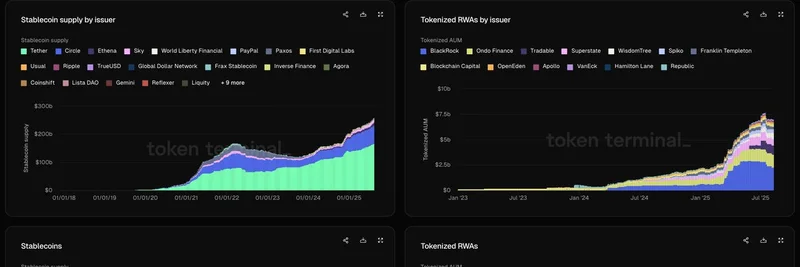If you're diving into the world of crypto, stablecoins and tokenized real-world assets (RWAs) are two pillars that keep things steady and connected to traditional finance. Stablecoins are cryptocurrencies designed to maintain a stable value, often pegged to the US dollar, making them perfect for trading without the wild swings of other coins. Tokenized RWAs, on the other hand, bring real-world items like bonds, real estate, or commodities onto the blockchain, allowing fractional ownership and easier trading.
Recently, Token Terminal shared a fascinating overview on X (formerly Twitter), breaking down these markets by chain, issuer, and product. Their charts paint a clear picture of growth and dominance in these sectors. Let's break it down step by step, so even if you're new to this, it all makes sense.
Stablecoins: The Backbone of Crypto Trading
Stablecoins have exploded in popularity because they provide liquidity and stability in the volatile crypto world. They're essential for trading meme tokens and other assets on decentralized exchanges (DEXs), as they act as a safe haven during market dips.
By Chain
Looking at the supply by blockchain chain, Ethereum leads the pack with its robust ecosystem, followed closely by Tron, which has gained traction for its low fees and speed—ideal for high-volume stablecoin transfers. Solana, Arbitrum One, Base, and others like BNB Chain and Avalanche make up the rest. The total supply has steadily climbed to around $300 billion as of mid-2025, showing how integral stablecoins are to the broader crypto economy.
By Issuer
When it comes to who issues these stablecoins, Tether (USDT) dominates with its massive supply across multiple chains. Circle's USDC comes in second, trusted for its transparency and regulatory compliance. Other players like DAI from MakerDAO, TrueUSD, and Paxos add diversity. This issuer breakdown highlights the concentration in a few big names, which could be a point of centralization risk but also ensures reliability.
By Product
Drilling down to specific products, USDT on Tron and Ethereum tops the list, with variations like USDC on Ethereum and Solana following. Niche ones like FDUSD on BNB Chain and others cater to specific ecosystems. The variety shows how stablecoins are tailored to different blockchains, enhancing usability for users in DeFi and beyond.
Tokenized RWAs: Bridging Crypto and Traditional Finance
Tokenized RWAs are exciting because they democratize access to assets traditionally locked in Wall Street. Think government bonds or gold tokenized on the blockchain—now anyone with a wallet can invest in fractions of these.
By Chain
Ethereum again takes the lead here, but newer layers like Base (an Ethereum Layer 2) are catching up quickly due to cheaper transactions. Chains like Solana, Arbitrum One, and Polygon are also seeing growth. The total tokenized RWA market is smaller, hovering around $10 billion, but it's growing fast, especially since early 2023.
By Issuer
Big traditional finance names are entering the space. BlackRock leads with its tokenized funds, followed by players like Ondo Finance, Tradable, and Superstate. Institutions like Franklin Templeton and WisdomTree are also tokenizing assets, signaling mainstream adoption. This issuer landscape shows how TradFi (traditional finance) is merging with crypto.
By Product
Products like BUIDL (BlackRock's tokenized fund) on Ethereum dominate, with others like OUSG (Ondo) and various treasury-related tokens following. The market is nascent, with values under $5 billion for most, but the upward trend is clear. These products offer yields from real-world investments, attracting investors looking for stable returns in crypto.
Why This Matters for Meme Tokens and Blockchain Practitioners
At Meme Insider, we're all about meme tokens, but understanding stablecoins and RWAs is crucial. Stablecoins fuel the liquidity needed for meme coin pumps, while tokenized RWAs could inspire new meme narratives around real-world tie-ins—like meme coins backed by tokenized assets. As the crypto space evolves, keeping an eye on these fundamentals helps you spot opportunities and risks.
Token Terminal's data underscores the maturation of crypto markets, with stablecoins providing the foundation and RWAs adding real economic value. If you're building or trading in blockchain, these insights can guide your strategies. Check out the original post for the full visuals, and stay tuned for more updates on how these trends impact the meme token world.


